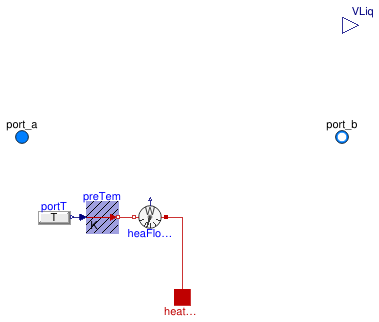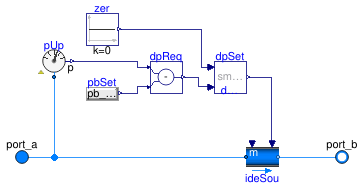Buildings.Experimental.DHC.Loads.Steam.BaseClasses
Package with base classes for Buildings.Experimental.DHC.Loads.Steam
Information
This package contains base classes that are used to construct the models in Buildings.Experimental.DHC.Loads.Steam.
Extends from Modelica.Icons.BasesPackage (Icon for packages containing base classes).
Package Content
| Name | Description |
|---|---|
| Control volume model exhibiting the condensation process of water | |
| Steam trap with isenthalpic expansion from high to atmospheric pressure, followed by a isobaric condensation process as flashed steam is brought back to a liquid state | |
| Ideal pressure reducing valve for steam heating systems | |
| Collection of models that illustrate model use and test models |
 Buildings.Experimental.DHC.Loads.Steam.BaseClasses.ControlVolumeCondensation
Buildings.Experimental.DHC.Loads.Steam.BaseClasses.ControlVolumeCondensation
Control volume model exhibiting the condensation process of water

Information
This model represents a condensation process of water with liquid and vapor phases in equilibrium and at a saturated state. Further information regarding the model formulation and assumptions are in the base class Buildings.Experimental.DHC.BaseClasses.Steam.PartialSaturatedControlVolume.
Reference
Hinkelman, Kathryn, Saranya Anbarasu, Michael Wetter, Antoine Gautier, and Wangda Zuo. 2022. “A Fast and Accurate Modeling Approach for Water and Steam Thermodynamics with Practical Applications in District Heating System Simulation.” Preprint. February 24. doi:10.13140/RG.2.2.20710.29762.
Extends from Buildings.Experimental.DHC.BaseClasses.Steam.PartialSaturatedControlVolume (Partial control volume for evaporation/condensation processes).
Parameters
| Type | Name | Default | Description |
|---|---|---|---|
| replaceable package Medium_a | PartialMedium | Medium model for port_a (inlet) | |
| replaceable package Medium_b | PartialMedium | Medium model for port_b (outlet) | |
| MassFlowRate | m_flow_small | 1E-4*abs(m_flow_nominal) | Small mass flow rate for regularization of zero flow [kg/s] |
| replaceable package MediumWat | TemperatureDependentDensity | Liquid water medium | |
| replaceable package MediumSte | Steam | Steam medium | |
| Volume | V | Total volume [m3] | |
| Nominal condition | |||
| MassFlowRate | m_flow_nominal | Nominal mass flow rate [kg/s] | |
| Initialization | |||
| VolumeFlowRate | VWat_flow.start | 0 | Volumetric flow rate of liquid water [m3/s] |
| Advanced | |||
| Diagnostics | |||
| Boolean | show_T | false | = true, if actual temperature at port is computed |
| Assumptions | |||
| Boolean | allowFlowReversal | true | = false to simplify equations, assuming, but not enforcing, no flow reversal. Used only if model has two ports. |
| Dynamics | |||
| Equations | |||
| Dynamics | energyDynamics | Modelica.Fluid.Types.Dynamic... | Type of energy balance: dynamic (3 initialization options) or steady state |
| Dynamics | massDynamics | energyDynamics | Type of mass balance: dynamic (3 initialization options) or steady state |
| Initialization | |||
| AbsolutePressure | p_start | MediumSte.p_default | Start value of pressure [Pa] |
| Volume | VWat_start | V/2 | Start value of liquid volume [m3] |
Connectors
| Type | Name | Description |
|---|---|---|
| replaceable package Medium_a | Medium model for port_a (inlet) | |
| replaceable package Medium_b | Medium model for port_b (outlet) | |
| FluidPort_a | port_a | Fluid connector a (positive design flow direction is from port_a to port_b) |
| FluidPort_b | port_b | Fluid connector b (positive design flow direction is from port_a to port_b) |
| HeatPort_a | heatPort | Heat port |
| output RealOutput | VLiq | Liquid volume [m3] |
Modelica definition
 Buildings.Experimental.DHC.Loads.Steam.BaseClasses.SteamTrap
Buildings.Experimental.DHC.Loads.Steam.BaseClasses.SteamTrap
Steam trap with isenthalpic expansion from high to atmospheric
pressure, followed by a isobaric condensation process as flashed steam
is brought back to a liquid state

Information
The steam trap ensures that only liquid condensate leaves the component, while any flashed steam is returned to a liquid state before discharge. The model assumes a steady state isenthalpic thermodynamic process that transforms water from an upstream high pressure state to atmospheric pressure, followed by an isobaric condensation process as flashed steam vapor is returned to a liquid state. This implementation is consistent with physical valves that vent to the atmosphere.
Extends from Buildings.Fluid.Interfaces.PartialTwoPortInterface (Partial model transporting fluid between two ports without storing mass or energy).
Parameters
| Type | Name | Default | Description |
|---|---|---|---|
| replaceable package Medium | PartialMedium | Medium in the component | |
| Nominal condition | |||
| MassFlowRate | m_flow_nominal | Nominal mass flow rate [kg/s] | |
| Assumptions | |||
| Boolean | allowFlowReversal | true | = false to simplify equations, assuming, but not enforcing, no flow reversal |
| Advanced | |||
| MassFlowRate | m_flow_small | 1E-4*abs(m_flow_nominal) | Small mass flow rate for regularization of zero flow [kg/s] |
| Diagnostics | |||
| Boolean | show_T | false | = true, if actual temperature at port is computed |
Connectors
| Type | Name | Description |
|---|---|---|
| replaceable package Medium | Medium in the component | |
| FluidPort_a | port_a | Fluid connector a (positive design flow direction is from port_a to port_b) |
| FluidPort_b | port_b | Fluid connector b (positive design flow direction is from port_a to port_b) |
| output RealOutput | QLos_flow | Heat transfer loss rate [W] |
Modelica definition
 Buildings.Experimental.DHC.Loads.Steam.BaseClasses.ValveSelfActing
Buildings.Experimental.DHC.Loads.Steam.BaseClasses.ValveSelfActing
Ideal pressure reducing valve for steam heating systems

Information
This is the model of self-acting control valve that automatically adjusts the diameter of valve orifice to reduce the unregulated inlet pressure to a constant, reduced outlet pressure.
Implementation
To simplify the complex relationships of the valve opening (y_actual),
mass flow rate (m_flow), and change in pressure (dp)
for compressible medium (such as steam), this model is implemented using an ideal source
Buildings.Fluid.Movers.BaseClasses.IdealSource, that allows the pressure drop
to be prescribed independently of mass flow rate.
The model maintains dp based on the user specified downstream pressure
value (pb_nominal), except for instances where the upstream pressure
falls below pb_nominal. In these instances, the valve exibits no
pressure drop (dpSet = 0) and asserts a warning.
This model assumes that dp across the valve is independent of
m_flow. This generally leads to a simplier set of equations.
Extends from Buildings.Fluid.Interfaces.PartialTwoPortInterface (Partial model transporting fluid between two ports without storing mass or energy).
Parameters
| Type | Name | Default | Description |
|---|---|---|---|
| replaceable package Medium | PartialMedium | Medium in the component | |
| Nominal condition | |||
| MassFlowRate | m_flow_nominal | Nominal mass flow rate [kg/s] | |
| Pressure | pb_nominal | Nominal outlet pressure [Pa] | |
| Assumptions | |||
| Boolean | allowFlowReversal | false | = false to simplify equations, assuming, but not enforcing, no flow reversal |
| Advanced | |||
| MassFlowRate | m_flow_small | 1E-4*abs(m_flow_nominal) | Small mass flow rate for regularization of zero flow [kg/s] |
| PressureDifference | dp_start | pb_nominal | Guess value of dp = port_a.p - port_b.p [Pa] |
| Diagnostics | |||
| Boolean | show_T | false | = true, if actual temperature at port is computed |
Connectors
| Type | Name | Description |
|---|---|---|
| FluidPort_a | port_a | Fluid connector a (positive design flow direction is from port_a to port_b) |
| FluidPort_b | port_b | Fluid connector b (positive design flow direction is from port_a to port_b) |
